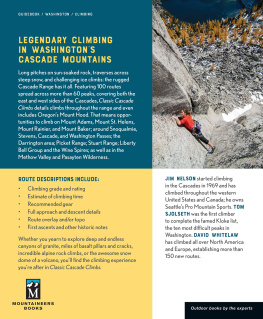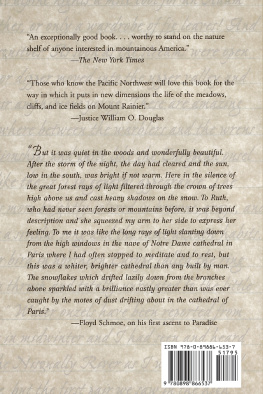Every mountain deserves a historian like Dee Molenaar. Several guidebooks detail the more than twenty-five climbing routes on Mount Rainier, but Molenaars The Challenge of Rainier remains unmatched. The updated fortieth anniversary edition is as fresh as the first with its comprehensive treatment of not only all of the key ascents, but also the drama that surrounds them, including the accidents and tragedies that have ensnared the unwary on Rainiers slopes. This is a rich, highly readable, and indispensable source for anyone interested in the Pacific Northwests greatest icon.
Jim Wickwire
first American, with Lou Riechardt, to summit K2
and co-author of Addicted to Danger
THE CHALLENGE
OF RAINIER

DEE MOLENAAR FOREWORD BY ED VIESTURS
THE CHALLENGE
OF RAINIER
A RECORD OF THE EXPLORATIONS AND ASCENTS, TRIUMPHS AND TRAGEDIES ON ONE OF NORTH AMERICAS GREATEST MOUNTAINS
40TH ANNIVERSARY | UPDATED 4TH EDITION

The Mountaineers Books is the nonprofit publishing arm of The Mountaineers, an organization founded in 1906 and dedicated to the exploration, preservation, and enjoyment of outdoor and wilderness areas.

1001 SW Klickitat Way, Suite 201, Seattle, WA 98134
Copyright 1971 and 1973 by The Mountaineers; 1979, 1987, and 2011 by Dee Molenaar First edition 1971; Second edition 1973; Third edition: 1979, 4th edition 2011
All rights reserved. No part of this book may be reproduced in any form, or by any electronic, mechanical, or other means, without permission in writing from the publisher and author.
Distributed in the United Kingdom by Cordee, www.cordee.co.uk
Manufactured in the United States of America
Cover and interior design: Heidi Smets Graphic Design, heidismets.com
Sketches and maps: Dee Molenaar
Cover Art: Dee Molenaar
Frontispiece: View of Mount Rainier, with customary lenticular cloud, from Pinnacle Saddle
Alan Bauer
Library of Congress Cataloging in Publication Data
Molenaar, Dee.
The challenge of Rainier : a record of the explorations and ascents, triumphs and tragedies on one of North Americas greatest mountains / Dee Molenaar. 4th ed.
p. cm.
Includes bibliographical references and index.
ISBN 978-1-59485-520-7 (pbk.) ISBN 978-1-59485-521-4 (ebook)
1. MountaineeringWashington (State)Rainier, MountGuidebooks. 2. Rainier, Mount (Wash.)Guidebooks. I. Title.
GV199.42.W22R345 2011
796.52209797782dc23
2011022196
 Printed on recycled paper
Printed on recycled paper
To Bill Butler (19002000) who for more than thirty years was wherever help was needed on the mountain... a legend in his time.... .
And to the many others to whom The Mountain continues to be a source of physical, mental, and spiritual inspiration and rejuvenation.
Greetings.
Across the width of the continent I stretch out my hand in greeting to you, Mountaineers, who are privileged to dwell within sight of the snow-crowned monarch of Puget Sound, and to feel daily the ennobling influence of his sublime presence. As I roam through the breadth of this land of ours and behold so many good people living their lives amid uninspiring surroundings, in cities of man-made sordidness, I feel impelled to tell them of that glorious vision upon which ever and anon you rest your eyes. More than once in the past few months has it been my pleasure to bid my friends in imagination to the flowering parks and crevassed ice fields and the mist-wrapped heights of Mount Rainier. More than once have I felt the revelation of it dawn upon them and awaken the desire to behold once, just once, though it take the savings of a lifetime, that which you see every day. To be envied indeed you are for your wonderful source of inspiration: were it possible for all other people to share it with you! No doubt the time will come when a pilgrimage to Mount Rainier shall be esteemed among the most precious joys, the most coveted privileges which a citizen of this country may hope to realize for himself or his fellows.
Franois E. Matthes
The Mountaineer, 1915
CONTENTS

FOREWORD TO THE FORTIETH ANNIVERSARY EDITION

Mount Rainier is our most iconic symbol of the Pacific Northwest. For those who live in these parts, Rainier is what Everest is to the people of Nepal, or Kilimanjaro is to the people of Africa. It dominates the skyline from many vantage points in Washington as it rises majestically above the surrounding peaks. From the Seattle area, it is a constant beacon seeming to float on the horizon, giving us comfort.
When the weather is cold and clear the snow and ice of Rainier shine like jewels. When heavy weather is impending, an angry cloudcap covers her summit. During the many cloudy days of winter she disappears from view and we miss her presence, but when she re-emerges against a blue sky, she often glitters with fresh snow and provides us with a sense of wonder, stirring the imagination.
I was drawn to the Northwest to begin what would become a love affair with mountains. My first view of Rainier was when I moved to Seattle in 1977 to go to school at the University of Washington. As we drove ever westward from my childhood home in Illinois, at last crossing the eastern plains of Washington, I was in awe as I watched not only the rugged Cascades emerging from the horizon but also the mountain called Rainier. (I learned later that locals often called it simply The Mountain.) I was transfixed. I had never seen anything so amazing. From my dorm room window I could also see Rainier. She inspired me to learn all that I could about climbing and to train as I started to dream about climbing to her summit. Rainier became my Everest.
Ive always tried to understand and get to know a mountain before attempting to climb it. I want to know its personality, its history, and its terrain, what others have experienced, the weather conditions, the flora and fauna, and its many faces. People have a single face they are recognized by, but a mountain has many. Each face presents a different image and for mountaineers a different challenge. By getting to know a mountain I feel more prepared to make a safe attempt to climb it. While there are many books written about Rainier, my bible became The Challenge of Rainier by Dee Molenaar. It was one of a few books about climbing in the Northwest that I devoured and kept handy. (Two other important books were Mountaineering: The Freedom of the Hills and Fred Beckeys amazingly detailed trilogy, the Cascade Alpine Guides.)
Although I had not met Dee Molenaar at the time, I knew of his climbing prowess on early ascents in the Northwest and, most notably, his attempt on K2 in 1953. He was one of my climbing heroes. Hed worked as guide on Rainier. He was an artist whose line drawings of many of the great mountains of the world were pictured in guidebooks and used as route maps by many climbers on their ascents.
Next page








 Printed on recycled paper
Printed on recycled paper